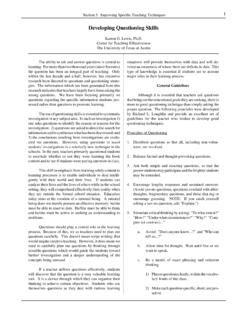Transcription of Evaluating Critical Thinking Skills: Two Conceptualizations
1 JOURNAL OF DISTANCE EDUCATIONREVUE DE L DUCATION DISTANCESPRING/PRINTEMPS 2005 VOL. 20, No 2, 1-20 Evaluating Critical Thinking skills : Two ConceptualizationsCheryl L. McLeanAbstractIn this study two complementary models, which were based on the strengths ofexisting models, were developed to analyze students Critical Thinking skills . Onemodel was used to categorize the types of Critical Thinking displayed by students;the other was used to evaluate the quality of the Critical Thinking . The models wererefined and tested for usefulness through an analysis of students messages postedin two sequential two-week computer conferences.
2 The study also examined thelevel of Critical Thinking displayed compared with that shown by other studies andhighlighted Critical Thinking skills that were not frequently demonstrated by sum Dans cette tude, deux mod les compl mentaires, bas s sur les points forts demod les existants, ont t d velopp s pour analyser la capacit de pens e critiquedes tudiants. Un mod le a t utilis pour cat goriser les types de pens e critiqued montr s par les tudiants, alors que l autre a t utilis pour valuer la qualit dela pens e critique.
3 Les mod les ont t raffin s et test s en fonction de leur utilit gr ce une analyse des messages des tudiants plac s dans deux forums num ri-ques s quentiels de deux semaines. L tude a aussi examin le niveau de pens ecritique d montr en comparaison avec celui indiqu dans d autres tudes et a misen lumi re des habilet s de la pens e critique peu fr quentes chez les (1998) points out that there is virtually no disagreement over theneed to help college students improve how they think (p. 450). Theliterature on Critical Thinking , however, suggests that many college stu-dents are not performing well on Critical Thinking tasks (King & Kitchener,1994; Paul, 1993).
4 Adding to the difficulty is the fact that there is nogenerally accepted definition of Critical Thinking ; nor is there a generallyaccepted model to evaluate Critical well-known authors have developed definitions of criticalthinking. Ennis (1987) bases his definition on five key ideas: practical,reflective, reasonable, belief, and action (p. 10), resulting in a workingARTICLES definition of: Critical Thinking is reasonable reflective Thinking that isfocused on deciding what to believe or do (p.)
5 10).Brookfield (1987) focuses on assumptions. His definition involvescalling into question the assumptions underlying our customary, habitualways of Thinking and acting and then being ready to think and act dif-ferently on the basis of this Critical questioning (p. 1). Both definitionshave elements of both product and process. The product is the decision madeabout Thinking or acting through the process of reflection or Brookfield points out that Critical Thinking is a process and notan outcome, this does not negate the product portion of his definition,which is Thinking or acting differently.
6 Brookfield s definition, with itsemphasis on assumptions, appears to be a little narrower than Ennis .Paul s (1993) definition is focused on the process. He defines criticalthinking asa unique kind of purposeful Thinking in which the thinker systematicallyand habitually imposes criteria and intellectual standards on the Thinking ,taking charge of the construction of Thinking , guiding the construction ofthe Thinking according to the standards, [and] assessing the effectivenessof the Thinking according to the purpose, the criteria, and the standards.
7 (p. 21)His description of the process is more detailed than either Ennis orBrookfield s, but his definition lacks an outcome or a definition of Critical Thinking even from the few listed aboveis difficult. Some, such as Ennis (1987), focus on both product and others, such as Paul (1993) and Brookfield (1987), the primary focus ison process. All the process definitions highlight specific Critical thinkingskills, but do not cover all aspects of Critical Thinking . Lipman (1991) pointsout that the current definitions are too vague and fail to note the charac-teristics of Critical Thinking .
8 However, it seems unreasonable to expect asingle definition to cover all the competences that might be displayed bycritical thinkers. Perhaps the definition is not the place to delineate thespecific skills . A model of Critical Thinking skills seems to be the moreappropriate venue to list and define Critical Thinking skills and of Critical ThinkingThe primary purposes of a model are to provide an accurate view of thephenomena under study and to facilitate communication about thosephenomena.
9 Ennis (1987) has designed a taxonomy of Critical thinkingdispositions and abilities. He lists 12 abilities that represent four basicareas of Critical Thinking : clarity, basis, inference, and interaction (p. 16).Ennis divides clarity into two groups: elementary and advanced, and2 CHERYL McLEAN includes focusing on a question, analyzing arguments, and asking andanswering questions of clarification and/or challenge in the elementarycategory. Advanced clarification includes defining terms and judging def-initions and identifying assumptions.
10 Basis, Ennis second basic area ofcritical Thinking , refers to the abilities to support one s inferences and toassess evidence. He includes judging the credibility of the source andobserving and judging observation reports. The third area, inference, in-cludes deducing and judging deductions, inducing and judging induc-tions, and making value judgments. The final area, interaction, focuses oninteracting with others and deciding on an action. The latter includes: a)define the problem, b) select criteria to judge possible solutions, c) formu-late alternative solutions, d) tentatively decide what to do, e) review,taking into account the total situation, and decide, f) monitor the im-plementation (p.












